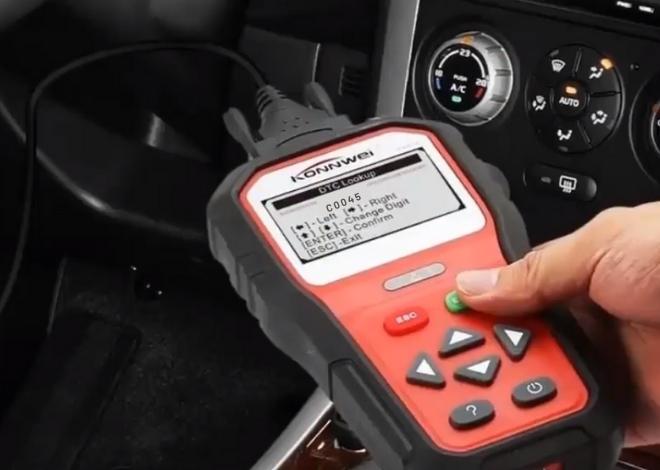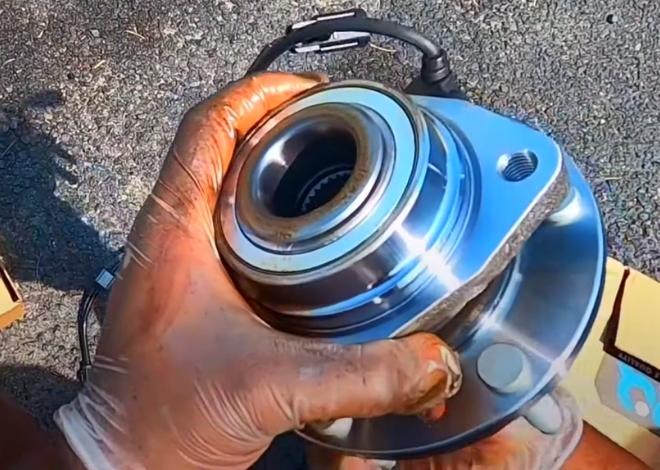Last Updated on May 21, 2025
If you’re a car owner or enthusiast, you’ve probably come across an OBD-II trouble code at some point. One such code is the C0045 code, which specifically refers to an issue with your vehicle’s left rear wheel speed sensor. Understanding this code is crucial for maintaining your car’s safety, especially when it comes to the Anti-lock Braking System (ABS).
In this article, we’ll walk you through the meaning of the C0045 code, common symptoms, diagnostic steps, and how to fix the problem effectively — even if you’re stuck on the road without immediate access to a mechanic.
✅ Pro Tip: Don’t ignore OBD-II codes like C0045. They often indicate hidden issues that, if left untreated, can compromise your braking system and overall driving safety.
What Is the C0045 Code?
The C0045 code is an OBD-II diagnostic trouble code that points to a malfunction in the left rear wheel speed sensor circuit. This sensor plays a key role in your car’s ABS and traction control systems by monitoring wheel speed and relaying data to the Electronic Brake Control Module (EBCM).
When this code appears, it usually means:
- The left rear wheel speed sensor is damaged, loose, or disconnected
- The sensor circuit is open or shorted
- The ABS module is not receiving accurate speed data from the sensor
This code can show up on diagnostic tools like a Fixd sensor or any standard OBD-II scanner.
How Does the Wheel Speed Sensor Work?
To understand the C0045 code, you need to know how a wheel speed sensor functions. Here’s a simplified explanation:
- The Electronic Brake Control Module (EBCM) sends ignition voltage to the wheel speed sensor.
- The sensor measures wheel rotation and returns a DC square wave signal to the EBCM.
- The frequency of this signal determines the speed at which the wheel is spinning.
- The EBCM uses this data to adjust ABS and traction control functionality in real-time.
If the sensor fails to send the correct signal due to damage or a wiring issue, the C0045 trouble code is triggered, and the ABS light may illuminate on your dashboard.
Common Symptoms of the C0045 Code
When your vehicle experiences a C0045 trouble code, there are several signs that can help you diagnose the problem early. Here are some of the most common symptoms associated with the C0045 code:

- ABS Warning Light On
- This is the most obvious sign. The ABS light turns on when the system detects an issue with the left rear speed sensor.
- Engine Warning Light
- In some vehicles, the Check Engine Light may also turn on due to sensor malfunction.
- Unresponsive Brakes or ABS Function
- The ABS system may not respond as expected during sudden braking.
- Loss of Traction Control
- Since traction control relies on accurate speed data, the system may become inactive if the sensor fails.
- Error Message on OBD-II Tool
- Diagnostic tools like the Fixd sensor will display the C0045 code, indicating an issue specifically with the left rear wheel speed sensor.
Possible Causes Behind the C0045 Trouble Code
The appearance of a C0045 code doesn’t always mean the sensor itself is bad. There can be multiple causes behind this trouble code, including:
- ✅ Damaged speed sensor
- ✅ Corroded or disconnected sensor wiring
- ✅ Poor electrical connection between the sensor and ABS module
- ✅ Broken reluctor ring on the wheel hub
- ✅ Faulty ABS control module (in rare cases)
If your car has been through harsh road conditions or winter driving, the wheel area may have taken damage or collected debris that affects the sensor’s performance.
🔗 Internal Link Suggestions:
For better understanding of OBD-II diagnostic tools and sensors, check out:
How to Diagnose the C0045 Code
Diagnosing the C0045 code is the first step toward fixing the issue. This process involves scanning for codes, inspecting components visually and mechanically, and verifying signal data from the speed sensor. Here’s how you can approach it step by step:
Step 1: Use an OBD-II Scanner
Start by plugging an OBD-II diagnostic tool into the vehicle’s port (usually located under the steering column).
- Turn on the ignition.
- Read the error codes.
- If you see C0045, focus on the left rear wheel speed sensor.
🔍 Tip: Make sure to clear other stored codes and focus only on current and pending ones related to C0045.
Step 2: Visually Inspect the Left Rear Wheel Speed Sensor
Once you’ve confirmed the C0045 code, it’s time to manually inspect the left rear wheel sensor and its wiring:
- Check if the sensor is physically damaged or covered in dirt.
- Look for corroded, frayed, or disconnected wires.
- Ensure that the harness connector is firmly attached to the sensor.
- Inspect the wheel hub for rust or damage near the reluctor ring (if applicable).
⚠️ Warning: A loose connection is one of the most common causes of this issue.
Step 3: Test Sensor Output with a Multimeter
To be more certain, use a multimeter to test the wheel speed sensor’s electrical output:
- Set the multimeter to DC voltage.
- Spin the wheel by hand while connected.
- You should see a square wave voltage signal or fluctuations in the reading.
If there’s no signal, the sensor is likely bad.
✅ Want to learn how to use a multimeter? Read: How to Test a Car Battery with a Multimeter
Step 4: Swap and Compare (Optional Test)
If you’re still unsure whether the sensor is faulty:
- Swap the left rear speed sensor with another functional one (e.g., from the right rear wheel).
- Clear the code and drive the vehicle briefly.
- If the error code shifts from C0045 to C0046, you’ve confirmed the sensor is defective.
How Much Does It Cost to Diagnose and Repair the C0045 Code?
Diagnosis Cost:
- Most auto shops charge between $75 and $150 per hour.
- DIY diagnosis with your own scanner can reduce costs significantly.
Repair Cost Breakdown:
| Component | Average Cost |
|---|---|
| Wheel Speed Sensor (OEM) | $50 – $120 |
| Labor (1–2 hours) | $75 – $300 |
| Total Estimated Cost | $125 – $420 |
The cost varies depending on:
- Your vehicle’s make and model
- Labor rates in your area
- Whether the sensor needs a simple fix or a complete replacement
Recommended Tools for Diagnosis & Repair
To diagnose and repair the C0045 code yourself, you’ll need:
- ✅ OBD-II scanner (e.g., Fixd, BlueDriver)
- ✅ Basic socket wrench set
- ✅ T30 Torx driver (for sensor bolt removal)
- ✅ Multimeter for testing voltage
- ✅ Replacement wheel speed sensor (OEM recommended)
- ✅ Jack stands and wheel chocks
- ✅ Brake cleaner and anti-seize lubricant (optional but helpful)
Can I Drive with the C0045 Code?
Technically, your vehicle may still be drivable. However, doing so is not recommended because:
- The ABS system may fail to operate properly
- You might lose traction control in slippery conditions
- The problem could cause uneven braking, which poses a safety risk
🛑 For your safety, fix the C0045 code as soon as possible to restore full braking and traction capabilities.
How to Fix the C0045 Code: Step-by-Step Repair Guide
Once you’ve diagnosed that the C0045 code is due to a faulty left rear wheel speed sensor or its wiring, it’s time to proceed with the actual repair. Below is a detailed step-by-step guide for replacing the sensor and restoring proper ABS functionality.
⚙️ Note: Always wear safety gloves, use a car jack stand, and activate the emergency brake before working under your vehicle.

Tools You’ll Need
- T30 Torx driver
- Socket wrench set
- New wheel speed sensor (OEM recommended)
- Brake cleaner
- Anti-seize lubricant (optional)
- Jack & jack stands
- Torque wrench (for proper bolt tightening)
- Screw tray or container (to avoid losing small parts)
How to Replace the Left Rear Wheel Speed Sensor
Step 1: Secure the Vehicle
- Park on a flat surface.
- Turn off the engine and activate the emergency brake.
- Place wheel chocks on the front wheels to prevent any movement.
Step 2: Lift the Vehicle and Remove the Wheel
- Use a car jack to lift the left rear side of the vehicle.
- Place jack stands securely under the car frame.
- Use a wrench to loosen and remove the lug nuts.
- Carefully remove the wheel to access the speed sensor.
🧰 Check out this related article for more on wheel issues: Symptoms of a Bad Starter
Step 3: Locate and Remove the Speed Sensor
- Identify the speed sensor mounted near the wheel hub.
- Use a T30 Torx bit to remove the sensor’s securing bolt.
- Carefully pull the sensor out; avoid using too much force as it may break.
Step 4: Disconnect the Wiring Harness
- Locate the wiring harness connector.
- Press the tab and disconnect the sensor cable from the main harness.
- Inspect the connector for corrosion or dirt, and clean if necessary.
Step 5: Install the New Sensor
- Connect the new sensor to the wiring harness.
- Apply a bit of anti-seize lubricant to the sensor body (optional).
- Insert the new sensor into place.
- Use your T30 driver to secure the bolt firmly, but do not over-tighten.
Step 6: Reinstall the Wheel
- Place the wheel back onto the hub.
- Hand-tighten the lug nuts in a star pattern.
- Lower the vehicle, then use a torque wrench to tighten the nuts to manufacturer specifications.
Step 7: Clear the Code
- Reconnect your OBD-II scanner and clear the C0045 code.
- Take a short test drive.
- If the code doesn’t return, your repair was successful!
What If the Problem Is With the Wheel?
If the C0045 trouble code persists even after sensor replacement, inspect the wheel hub assembly. A damaged or misaligned reluctor ring on the wheel can also interfere with sensor readings.
Steps to Replace the Left Rear Wheel (If Required)
- Activate the emergency brake.
- Jack up the vehicle and remove the wheel as described above.
- Inspect the wheel hub assembly and reluctor ring.
- If the wheel is damaged beyond repair, replace it with a new unit.
- Reinstall everything following the reverse order.
📌 Related: Need to inspect sensor wiring too? Read Bad Clutch Master Cylinder Symptoms — it shares helpful techniques for handling sensitive components.
Final Testing
After completing the sensor or wheel replacement:
- Use your scanner to run another diagnostic.
- If no C0045 code appears, the issue is resolved.
- Drive your car in a safe area and test the brakes. The ABS light should stay off and braking should feel smooth.
DIY vs. Mechanic Repair: Which is Better?
If you’re confident with tools and have the time, fixing the C0045 code yourself can save hundreds of dollars. However, if the sensor is deeply integrated into the hub or you’re dealing with additional ABS module issues, it’s best to hire a professional.
How to Prevent the C0045 Code from Coming Back
Fixing the C0045 code is just part of the solution. To ensure your vehicle remains in top condition and the issue doesn’t recur, follow these long-term preventive maintenance tips and best practices.
1. Regular Wheel Sensor Inspections
Inspect your wheel speed sensors every 6–12 months, especially if you frequently drive on rough terrain, in heavy rain, or snow. Look for:
- Dirt and debris buildup
- Corrosion around the sensor and connector
- Loose or damaged wires
💡 Periodic checks can help detect early signs of failure before triggering the C0045 trouble code.
2. Clean Your Wheel Hubs
A dirty or rusted reluctor ring can interfere with the sensor’s ability to read wheel speed accurately.
- Use brake cleaner to remove grime
- Avoid high-pressure water near sensors and connectors
- Inspect for cracks or missing teeth on the reluctor ring
3. Use OEM Parts
Always replace your speed sensors with OEM (Original Equipment Manufacturer) components, especially for ABS systems.
- Cheaper aftermarket parts may not match signal requirements
- Poor quality sensors often fail within months, causing the C0045 code to reappear
4. Secure All Wiring Properly
Loose or hanging wires near the wheel well can easily:
- Be damaged by road debris
- Disconnect due to vibrations
- Corrode when exposed to moisture
Use zip ties or clips to route and secure the wiring away from moving components.
Common Mistakes When Fixing the C0045 Code
Avoid these common errors that could either cause the code to return or damage your vehicle’s braking system:
1. Over-Tightening the Sensor Bolt
Applying too much force can strip the threads or crack the sensor housing, leading to improper readings or permanent failure.
2. Not Cleaning the Mounting Surface
Installing a new sensor on a dirty or rusted mounting surface can throw off alignment and result in inconsistent wheel speed data.
3. Skipping the Test Drive
After installation, always perform a short drive:
- Ensure the ABS and engine lights stay off
- Monitor for any braking irregularities
- Scan again with your OBD-II tool to confirm no more trouble codes
4. Replacing the Wrong Sensor
Some people misdiagnose the problem and replace a working sensor, which wastes money and time. Always test the sensor output with a multimeter or swap sides to confirm the faulty one.
Expert Suggestions to Avoid Future Sensor Issues
Here are a few insider tips that professional mechanics recommend:
Rotate Tires Regularly
When rotating tires, inspect the area around the speed sensors. This ensures:
- Even wear on tires
- Balanced sensor performance
- Opportunity to check for loose connectors or broken clips
Perform a Full Brake System Check Annually
The ABS system relies heavily on sensors. An annual checkup can detect:
- Failing calipers
- Leaking brake fluid
- Loose ABS module connections
🔗 Need more help with brake systems? Read: Bad Brake Light Switch Symptoms
Be Cautious with Aftermarket Wheels
Installing aftermarket wheels without proper sensor clearance can interfere with signal reading. Make sure:
- The sensor mounting remains unobstructed
- Wheels are ABS-compatible
- Reluctor rings remain undamaged during installation
Wash Undercarriage in Winter
If you drive in snowy or icy areas where roads are salted:
- Salt and grime can build up around the sensor
- This leads to corrosion and inaccurate readings
- Use a gentle undercarriage wash every few weeks in winter
Final Thoughts on the C0045 Code
The C0045 code may seem like a minor technical glitch, but it plays a critical role in ensuring your vehicle’s braking and safety systems function properly. Left unresolved, it can impact the ABS, traction control, and even lead to unpredictable braking behavior — especially dangerous in wet or icy conditions.
By following the steps outlined in this guide — from accurate diagnosis and sensor replacement to long-term prevention and maintenance — you can confidently fix this issue and avoid costly future repairs.
Whether you’re a DIY enthusiast or prefer a professional mechanic, understanding this code empowers you to make smart decisions about your vehicle’s health.
🚗 Want to become more confident in car maintenance? Explore more helpful guides on TheEffectiveGuide.com.
Frequently Asked Questions (FAQs) about the C0045 Code
Q1. What does the C0045 code mean?
A: It refers to a malfunction in the left rear wheel speed sensor circuit. The sensor may be damaged, dirty, misaligned, or have faulty wiring that causes incorrect data transmission to the ABS module.
Q2. Can I drive with a C0045 trouble code?
A: Technically yes, but it’s not recommended. Your ABS and traction control systems may not function properly, increasing the risk of an accident in emergencies.
Q3. How long does it take to fix the C0045 code?
A: Replacing the wheel speed sensor typically takes 30–60 minutes if you’re experienced with basic car repairs. Add more time if inspecting or replacing the wheel hub.
Q4. Will the C0045 code clear itself?
A: No. Even if the issue is intermittent, you must clear the code manually using an OBD-II scanner after making necessary repairs.
Q5. Is the C0045 code specific to one car brand?
A: No. While some models like Chevrolet, GMC, Buick, and Cadillac report it more frequently, the code is used in most OBD-II compliant vehicles with ABS.
🔗 Internal Link Recap for Related Topics
Here are some highly relevant internal articles for readers wanting to learn more about vehicle codes and car repair:
- 🔋 How to Test a Car Battery with a Multimeter
- 🚨 Symptoms of a Bad Starter
- 💡 U0002 Code – High-Speed Communication Bus
- 🚦 Bad Brake Light Switch Symptoms
- 🛞 Bad Clutch Master Cylinder Symptoms
- 🚗 C0045 Code – What You Should Know ← link from other posts to this one
Final Recommendation
If you’re seeing the C0045 code on your OBD-II scanner, don’t delay the fix. Whether it’s just a loose connector or a faulty sensor, your braking system relies on this small component to keep you and your passengers safe.
Bookmark this guide or share it with others who may be facing similar vehicle issues. Keeping your car’s ABS in top shape is not just about performance — it’s about safety.
Meet our professional car mechanic, Russell D. Steele, who has been in this field for five consecutive years and works with several automotive companies. He completed the "AUTOMOTIVE & LIGHT DUTY DIESEL TECHNOLOGY" course from NorthWest Lowa Community College, where he learned essential diagnostic and transportation management skills and became a certified mechanic.
